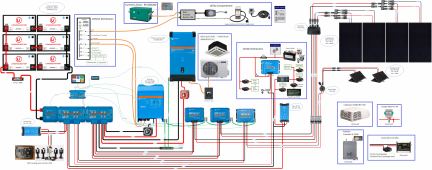1. The rig is a Class-C motorhome on a Sprinter VS30 chassis (Winnebago Navion), configured for 30A service.
2. Factory-installed options include:
Total House Battery Capacity = 390Ah @ 24V
The intent is to run the Min-Split 24/7, if possible, which will be a tall order in Florida... Your feedback is appreciated.
--EDIT--
BTW, the inspiration for this project was this YouTube video, which claims a 460W average consumption from a 9K Btu Mini-Split:
009 - [Redo] Solar Mini Split Air Conditioner Runs 24/7/365 Day & Night

2. Factory-installed options include:
a) 30A Diesel Generator (Cummins/Onan)
b) (2 * 130Ah) LiFePO4/12V batteries (Lithionics)
c) (2 * 100W) solar panels with 30A PWM controller (Zamp)
d) 2KW Inverter/Charger (Xantrex)
3. My plan is to:a) Remove rooftop A/C+Heat Pump, and install 9K Btu Mini-Split with Cassette unit
b) Remove 30A PWM controller and install MPPT controllers
c) Remove (2 * 100W) panels from the roof, and install (4 * 425W) panels on the roof
NOTE: The (2* 100W) panels will then be used as Portable, via existing Ground-level entry port
d) Remove 2KW Inverter/Charger, and install 3KW Inverter/Charger (mainly to increase charging capacity)
e) Add (4 * 130Ah) LiFePO4/12V batteries, and configure all 6 as a 24V battery bank (2S, 3P configuration)
f) Add 230V Inverter to run Mini-Split (9A Minimum Ampacity, at 230VAC)
g) Remove Mastervolt charger, and install 12V-24V (15A) Smart Charger (with 3-Stage charging profile)
h) Add 24V-12V DC-DC Converters for DC loads
Total Solar Capacity = 1900W (1700W on rooftop + 200W Portable)Total House Battery Capacity = 390Ah @ 24V
The intent is to run the Min-Split 24/7, if possible, which will be a tall order in Florida... Your feedback is appreciated.
--EDIT--
BTW, the inspiration for this project was this YouTube video, which claims a 460W average consumption from a 9K Btu Mini-Split:
009 - [Redo] Solar Mini Split Air Conditioner Runs 24/7/365 Day & Night

Last edited:


